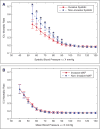Methods of blood pressure measurement in the ICU
- PMID: 23269127
- PMCID: PMC3724452
- DOI: 10.1097/CCM.0b013e318265ea46
Methods of blood pressure measurement in the ICU
Abstract
Objective: Minimal clinical research has investigated the significance of different blood pressure monitoring techniques in the ICU and whether systolic vs. mean blood pressures should be targeted in therapeutic protocols and in defining clinical study cohorts. The objectives of this study are to compare real-world invasive arterial blood pressure with noninvasive blood pressure, and to determine if differences between the two techniques have clinical implications.
Design: We conducted a retrospective study comparing invasive arterial blood pressure and noninvasive blood pressure measurements using a large ICU database. We performed pairwise comparison between concurrent measures of invasive arterial blood pressure and noninvasive blood pressure. We studied the association of systolic and mean invasive arterial blood pressure and noninvasive blood pressure with acute kidney injury, and with ICU mortality.
Setting: Adult intensive care units at a tertiary care hospital.
Patients: Adult patients admitted to intensive care units between 2001 and 2007.
Interventions: None.
Measurements and main results: Pairwise analysis of 27,022 simultaneously measured invasive arterial blood pressure/noninvasive blood pressure pairs indicated that noninvasive blood pressure overestimated systolic invasive arterial blood pressure during hypotension. Analysis of acute kidney injury and ICU mortality involved 1,633 and 4,957 patients, respectively. Our results indicated that hypotensive systolic noninvasive blood pressure readings were associated with a higher acute kidney injury prevalence (p = 0.008) and ICU mortality (p < 0.001) than systolic invasive arterial blood pressure in the same range (≤70 mm Hg). Noninvasive blood pressure and invasive arterial blood pressure mean arterial pressures showed better agreement; acute kidney injury prevalence (p = 0.28) and ICU mortality (p = 0.76) associated with hypotensive mean arterial pressure readings (≤60 mm Hg) were independent of measurement technique.
Conclusions: Clinically significant discrepancies exist between invasive and noninvasive systolic blood pressure measurements during hypotension. Mean blood pressure from both techniques may be interpreted in a consistent manner in assessing patients' prognosis. Our results suggest that mean rather than systolic blood pressure is the preferred metric in the ICU to guide therapy.
Conflict of interest statement
The authors have not disclosed any potential conflicts of interest.
Figures



Comment in
-
Measuring mean or systolic arterial pressure in critically ill patients? Invasively or noninvasively? Does it matter?Crit Care Med. 2013 Jan;41(1):333-4. doi: 10.1097/CCM.0b013e318270dfa7. Crit Care Med. 2013. PMID: 23269136 No abstract available.
References
-
- Marino P, Sutin K. The ICU Book. Philadelphia, PA: Lippincott, Williams & Wilkins; 2007.
-
- Antonelli M, Levy M, Andrews PJ, et al. Hemodynamic monitoring in shock and implications for management. International Consensus Conference, Paris, France, 27–28 April 2006. Intensive Care Med. 2007;33:575–590. - PubMed
-
- McGhee BH, Bridges EJ. Monitoring arterial blood pressure: What you may not know. Crit Care Nurse. 2002;22:60–79. - PubMed
-
- Gardner RM. Direct arterial pressure monitoring. Curr Anaesth Crit Care. 1990;1:239–246.
-
- Bur A, Herkner H, Vlcek M, et al. Factors influencing the accuracy of oscillometric blood pressure measurement in critically ill patients. Crit Care Med. 2003;31:793–799. - PubMed
Publication types
MeSH terms
Grants and funding
LinkOut - more resources
Full Text Sources
Other Literature Sources

